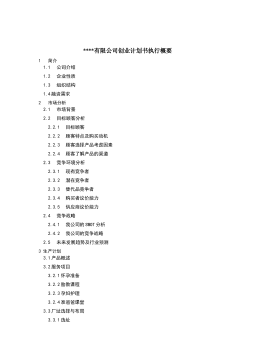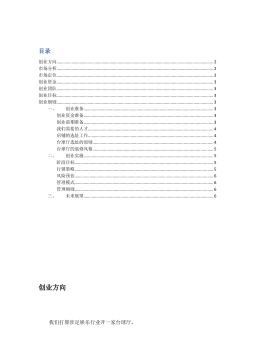USST_Arts_112451340金属掺杂有序介孔碳复合材料研制及其去除氯代芳香族化合物的性能研究
VIP免费
摘 要
氯代芳香族化合物(CPs)因其极高的生物毒性、极大的生物难降解性、超强
的生物累积性等特殊性质,被公认为环境净化领域的一大世界难题。传统的物理
化学处理成本很高,生物处理效果非常微弱,因此研究人员开始将新兴的可见光
光催化降解技术应用到该领域以期获得环境净化和清洁能源利用的双重突破。本
研究将具有优越吸附性能的金属镍掺杂有序介孔碳材料和具有极强可见光光催化
性能的石墨型氮化碳材料进行结合,制备出了金属镍掺杂有序介孔碳复合材料。
采用 XRD、BET、SEM、TEM 和UV-Vis 分别对介孔碳材料、氮化碳材料以及复
合材料进行了表征;研究了介孔碳材料的吸附性能,石墨型氮化碳以及复合材料
的光催化性能。利用高效液相色谱和气质联用技术对复合材料降解 2.4-DCP 的中
间产物进行分析,并且对其降解途径和机理进行了初步的探讨。
主要研究内容及结论如下:
(1) 以商业化的阳离子表面活性剂三嵌段共聚物 F127 为软模板,碱性酚醛树
脂为碳源,硝酸镍为金属化合物,通过溶剂挥发诱导自组装法和高温碳化制备了
金属镍掺杂有序介孔碳材料。XRD、BET 和TEM 表征结果证明材料具有很好的有
序介孔结构、高比表面积和孔容量等优良性能。罗丹明 B吸附实验结果说明材料
有极高的吸附速率和吸附容量,吸附过程遵循准二级动力学模型和 Langmuir 吸附
等温线模型的规律。
(2) 以价廉易得的三聚氰胺为原材料,利用不同温度煅烧缩聚的方法制备了石
墨型氮化碳材料,XRD、SEM 和UV-Vis 表征结果说明材料具有很好的氮化碳层状
结构和很强的可见光响应能力。罗丹明 B的光催化实验表明 580℃的煅烧温度时材
料的可见光和太阳光照射下的光催化性能最高。
(3) 将金属镍掺杂有序介孔碳材料和石墨型氮化碳材料简单混合煅烧制备了
金属镍掺杂有序介孔碳复合材料。XRD、BET 和UV-Vis 表征结果说明复合材料有
很高的比表面积和极高的可见光响应能力,催化降解罗丹明 B的实验证明介孔碳
比例为 4%时光催化效率和去除率最高。
(4) 金属镍掺杂有序介孔碳复合材料对 2.4-2 氯酚(2.4-DCP)的光催化效果良好,
在材料投加量为 0.5 g/L,光照时间为 240 min,初始浓度为 20 mg/L 的条件下,降
解效果高达 95.25%,远高于纯氮化碳材料。
(5) 对 2.4-DCP 的光催化降解产物进行分析发现,苯环上的 C-Cl 键被光催化
剂产生的
OH
自由基氧化断裂,生成的
-
lC
游离于溶液中,生成的有机小分子中
间产物则进一步被羟基自由基降解,动力学分析结果为一级反应。
关键词:介孔碳 氮化碳 复合材料 氯代芳香族化合物 吸附 光催化
ABSTRACT
Degradation of CPs is one of the greatest world-wise challenges in the
environmental purification, because of the high toxicity, bioaccumulation and
persistence, etc. Treatments of physics and chemistry are either high-cost or low
efficiency, hence some investigators recently has turned to the rising photocatalysis
technique hoping to gain the breakthroughs of environmental purification and clean
energy utilization. In this study, metal doped ordered mesoporous carbon (C)
composites was synthesized by combining the efficient adsorbent nickel doped ordered
mesoporous carbon with the superior photocatalyst graphite carbon nitride (g-C3N4).
The composites were characterized by XRD, BET, FESEM, TEM and UV-Vis
techniques, and, the adsorption activities of nickel doped ordered mesoporous carbon
were studied, so did the photocatalytic activities of g-C3N4 and g-C3N4/C materials.
Intermediate products generated during the photodegradation of 2.4-dlchlorophenol
(2.4-DCP) were analyzed by HPLC and GC-MS methods, and the degradation pathway
and mechanism were proposed.
Main conclusions of this paper are summarized as below:
(1) Nickel doped ordered mesoporous carbon materials were synthesized in EISA
(Evaporation Induced Self-Assembly) way by using commercial surfactant triblock
copolymer F127 as soft-template, alkaline phenolic resin as carbon precursors,
nickelous nitrate as metallic compounds. Results of XRD, BET and TEM
Characterization indicated that mesoporous carbon owned well-ordered mesoporous
structures, high specific surface area and pore volumes. Adsorption tests of Rhodamine
B (RhB) showed that as-achieved carbon materials had fast adsorption rate and high
loading capacity, and the process was well-fitted with the pseudo second-order rate
equation and Langmuir adsorption isotherm.
(2) Graphite carbon nitride was achieved by thermal treatments of the cheap and
convenient melamine at different temperatures, XRD, SEM and UV-Vis characterization
results showed as-synthesized g-C3N4 had well-maintained graphitic stacking structures
and strong response abilities of visible light. The catalytic test results of RhB solution
indicated that the sample calcined at 580 ℃ had the highest photocatalytic activities
under the irradiation of both visible-light and sun-light.
(3) Nickel doped ordered mesoporous carbon composites were synthesized by
low-temperature thermal treatment of the mixtures of as-prepared C and g-C3N4
materials. XRD, SEM and UV-Vis characterization results indicated that as-achieved
samples had high specific surface area and strong visible-light response abilities,
catalytic test results of RhB showed that sample g-C3N4/C-4 had the highest
photocatalytic efficiency and removal rate, which had 4 wt% of mesoporous carbon.
(4) The g-C3N4/C-4 composites showed the highest photocatalytic ability with
degradation rate up to 95.25%, which was much higher than pure g-C3N4, in
concentration of 2.4-DCP 20 mg/L under conditions of 0.5 g/L and illumination time of
240 min.
(5) Photocatalytic degradation of 2.4-DCP products were found through analysis
that C-Cl bond on benzene ring was oxidized and then fractured by hydroxyl radical
from photocatalyst,Cl substitute became free
-
lC
existing in the solution,2.4-DCP
was degraded by
OH
and generated intermediate product of small molecule organic,
and small molecule organics were further degraded under photocatalysis. Through
kinetic analysis of reaction La-S-TiO2/SBA-15 catalysis on degradation rate of 2.4-DCP
followed first-order reaction.
Key words: Mesoporous carbon, carbon nitride, composites,
chlorinated aromatic compounds, adsorption, photocatalysis;
目 录
中文摘要
Abstract
第一章 绪 论 ..................................................................................................................... 1
1.1 概述 .......................................................................................................................................... 1
1.2 CPs 废水处理研究进展 ........................................................................................................ 2
1.2.1 生物降解处理法 ........................................................................................... 2
1.2.2 物理吸附去除法 ........................................................................................... 2
1.2.3 催化氧化法 ................................................................................................... 2
1.2.4 其他处理技术 ............................................................................................... 3
1.3 有序介孔碳复合材料的研究现状 ..................................................................................... 3
1.3.1 硬模板法 ....................................................................................................... 4
1.3.2 软模板法 ....................................................................................................... 5
1.4 光催化剂的研究进展 ............................................................................................................ 7
1.4.1 常见光催化剂的研究 ................................................................................... 7
1.4.2 石墨型氮化碳材料的研究进展 ................................................................... 8
1.5 本文的研究思路和研究内容 ............................................................................................. 9
1.5.1 技术路线 ....................................................................................................... 9
1.5.2 研究内容 ..................................................................................................... 10
1.5.3 创新之处 ..................................................................................................... 11
第二章 金属掺杂有序介孔碳材料的制备和性能研究 ................................................... 12
2.1 实验部分 ............................................................................................................................... 12
2.1.1 实验材料和设备仪器 ................................................................................. 12
2.1.2 介孔碳材料的制备 ..................................................................................... 13
2.1.3 介孔碳材料的表征 ..................................................................................... 13
2.1.4 介孔碳材料的吸附试验 ............................................................................. 14
2.1.5 吸附动力学模型的选择 ............................................................................. 15
2.1.6 吸附等温线模型的选择 ............................................................................. 16
2.2 结果与讨论 ........................................................................................................................... 18
2.2.1 XRD 分析 ..................................................................................................... 18
2.2.2 N2吸附脱附分析 ......................................................................................... 19
2.2.3 TEM 分析 ..................................................................................................... 19
2.2.4 罗丹明 B溶液的标准曲线 ........................................................................ 20
2.2.5 吸附影响因素实验结果分析 ..................................................................... 21
2.2.6 吸附速率模型分析 ..................................................................................... 24
2.2.7 吸附等温线分析 .......................................................................................... 25
2.3 本章小结 ............................................................................................................................... 27
第三章 石墨型氮化碳材料的制备和光催化性能测试 ................................................... 28
3.1 实验部分 ............................................................................................................................... 28
3.1.1 试剂和仪器 ................................................................................................. 28
3.1.2 催化剂的制备 ............................................................................................. 29
3.1.3 催化剂的表征 ............................................................................................. 29
3.1.4 催化剂的光催化实验 ................................................................................. 30
3.2 结果与讨论 ........................................................................................................................... 30
3.2.1 XRD 结果分析 ............................................................................................. 30
3.2.2 催化剂结构分析 ......................................................................................... 30
3.2.3 紫外-可见漫反射吸收光谱分析 ................................................................ 31
3.2.4 光催化性能分析 ......................................................................................... 32
3.3 本章小结 ............................................................................................................................... 33
第四章 介孔碳复合材料的制备和性能研究 ................................................................... 34
4.1 实验部分 ............................................................................................................................... 34
4.1.1 试剂和仪器 ................................................................................................. 34
4.1.2 复合材料的制备 ......................................................................................... 35
4.1.3 复合材料的表征 ......................................................................................... 35
4.1.4 复合材料的吸附和光催化实验 ................................................................. 36
4.2 结果与讨论 ........................................................................................................................... 36
4.2.1 XRD 结果分析 ............................................................................................. 36
4.2.2 N2吸附脱附分析 ......................................................................................... 37
4.2.3 紫外-可见漫反射吸收光谱分析 ................................................................ 39
4.2.4 复合材料吸附试验结果分析 ..................................................................... 39
4.2.5 复合材料光催化试验结果分析 .................................................................. 40
4.3 本章小结 ............................................................................................................................... 42
第五章 介孔碳复合材料吸附和催化降解 2.4-2 氯酚的实验研究 ................................. 44
5.1 实验部分 ............................................................................................................................... 44
5.1.1 试剂和仪器 ................................................................................................. 44
5.1.2 DCP 检测方法 ............................................................................................. 44
5.1.3 2.4-DCP 的吸附和光催化实验 ................................................................... 45
5.2 结果与讨论 ........................................................................................................................... 46
5.2.1 2.4-DCP 的标准曲线绘制 ........................................................................... 46
5.2.2 2.4-DCP 吸附试验结果分析 ....................................................................... 47
5.2.3 2.4-DCP 光催化试验结果分析 ................................................................... 48
5.2.4 DCP 光催化降解机理分析 ......................................................................... 51
5.2.5 动力学研究 ................................................................................................. 56
5.3 本章小结 ............................................................................................................................... 58
第六章 结论与建议 ........................................................................................................... 59
6.1 结论 ........................................................................................................................................ 59
6.2 建议 ......................................................................................................................................... 60
参考文献 ............................................................................................................................. 61
在读期间公开发表的论文和承担科研项目及取得成果 ................................................. 66
致 谢 ................................................................................................................................. 68
相关推荐
-
我国基层财政困难的制度成因分析与对策研究VIP免费
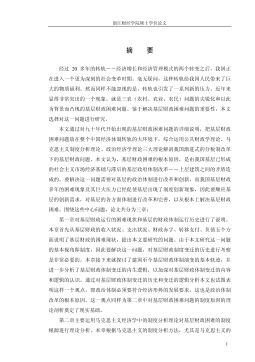
 2024-09-20 33
2024-09-20 33 -
我国煤电产业链纵向交易合约机制研究VIP免费
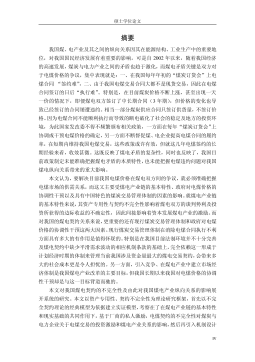
 2024-09-20 28
2024-09-20 28 -
生产要素视角下的上海市产业结构优化研究VIP免费
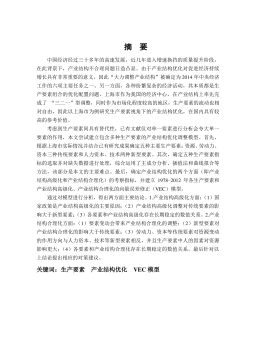
 2025-01-09 7
2025-01-09 7 -
我国银行业结构与经济结构关系研究VIP免费
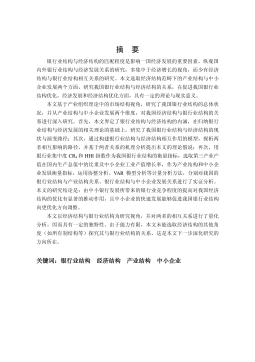
 2025-01-09 7
2025-01-09 7 -
大数据视角下农业供应链金融研究VIP免费

 2025-01-09 6
2025-01-09 6 -
跨国大型综合超市的规划研究VIP免费
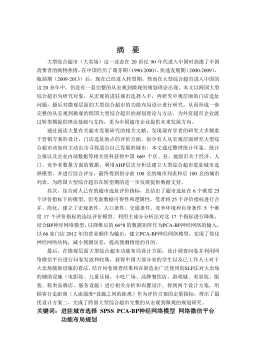
 2025-01-09 6
2025-01-09 6 -
跨境电商农产品质量安全问题研究VIP免费
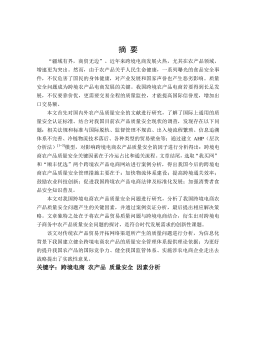
 2025-01-09 7
2025-01-09 7 -
世界市场的虚拟化与我国国际电子商务发展方向研究VIP免费
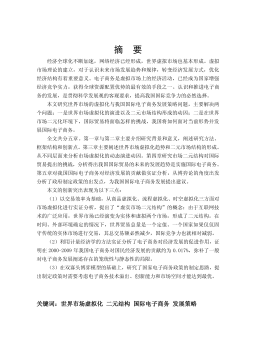
 2025-01-09 9
2025-01-09 9 -
中国政府对电力行业的价格规制问题研究VIP免费
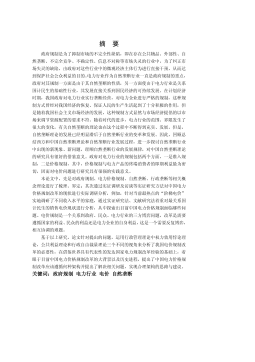
 2025-01-09 14
2025-01-09 14 -
中小企业信息化系统集成技术研究VIP免费
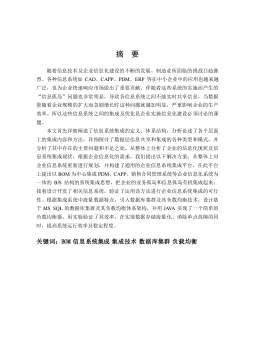
 2025-01-09 14
2025-01-09 14
作者:牛悦
分类:高等教育资料
价格:15积分
属性:71 页
大小:4.12MB
格式:PDF
时间:2025-01-09
相关内容
-

跨国大型综合超市的规划研究
分类:高等教育资料
时间:2025-01-09
标签:无
格式:PDF
价格:15 积分
-

跨境电商农产品质量安全问题研究
分类:高等教育资料
时间:2025-01-09
标签:无
格式:PDF
价格:15 积分
-

世界市场的虚拟化与我国国际电子商务发展方向研究
分类:高等教育资料
时间:2025-01-09
标签:无
格式:PDF
价格:15 积分
-

中国政府对电力行业的价格规制问题研究
分类:高等教育资料
时间:2025-01-09
标签:无
格式:PDF
价格:15 积分
-

中小企业信息化系统集成技术研究
分类:高等教育资料
时间:2025-01-09
标签:无
格式:PDF
价格:15 积分


